Apollo 11: The inside story from rivalry between the astronauts to Buzz Aldrin's secret tragedy
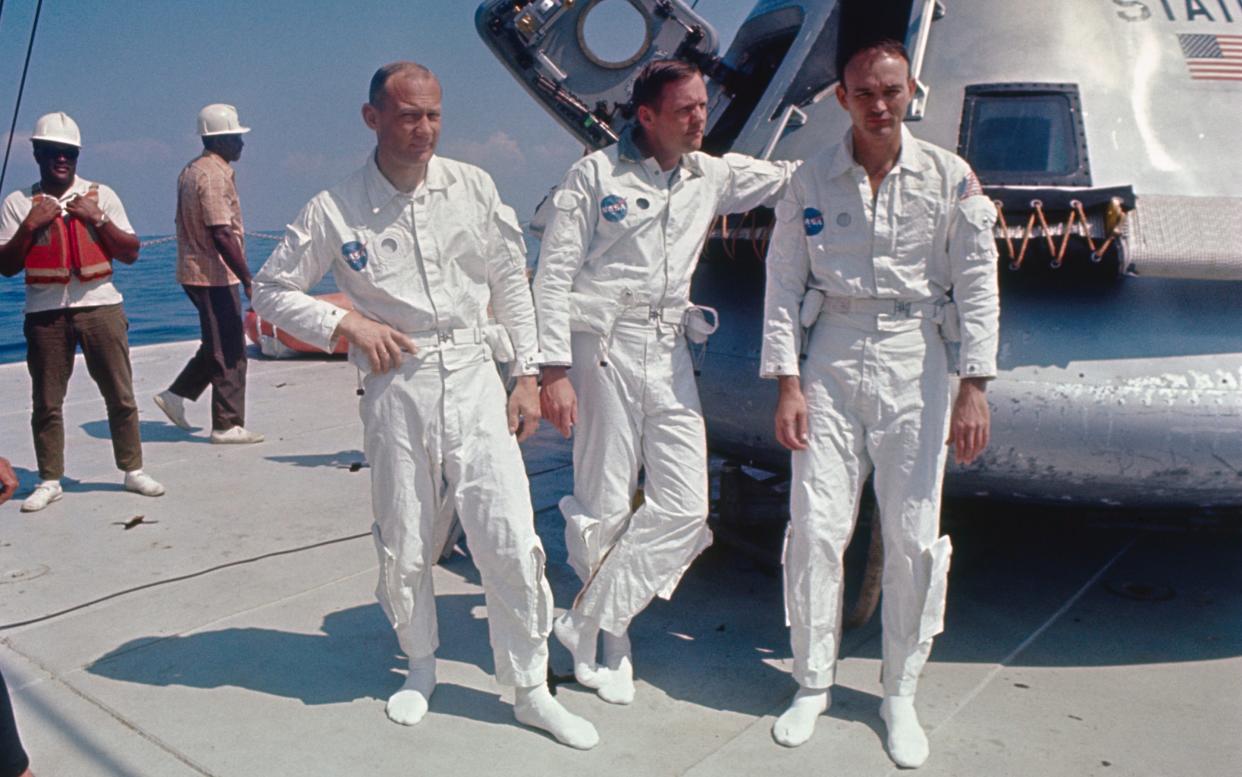
Fifty years ago, Neil Armstrong became the first person to walk on the moon. Here, Robert Stone and Alan Andres tell the story of a journey that changed the world
It was a glorious New York tradition, which originated at the end of the 19th century with the dedication of the Statue of Liberty. Since then Manhattan had held more than 160 ticker-tape parades to celebrate visits from kings, queens, generals, sports heroes, explorers, and aviators. When the astronauts of Apollo 8 [the first mission to take humans to the vicinity of the moon] arrived in the city in early January 1969, there was no question: a ticker-tape parade was obligatory.
More than 200 tons of confetti and scrap paper were transformed into a chaotic celebratory blizzard by the force of the bitter January winds rushing down the canyon of Sixth Avenue. [The astronauts] Frank Borman, Jim Lovell, and Bill Anders smiled and waved at the hundreds of thousands of well-wishers.
When the motorcade crossed on to Broadway, [they] noticed that the avenue’s signs had been changed to read Apollo Way.
At precisely the same moment, journalists were gathering in an auditorium in Houston to meet another Apollo crew. Here there were no celebrations or marching bands. Instead, Nasa was introducing the newly named crew of what was expected to be the first mission to attempt a landing on the moon – in just six months.
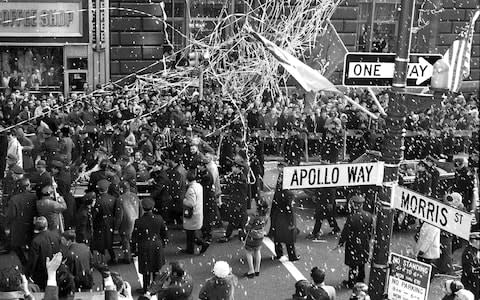
Unlike the Apollo 8 crew, the Apollo 11 crew – Neil Armstrong, the commander; Buzz Aldrin, the lunar-module pilot; and Michael Collins, the command-module pilot who would remain in orbit above the moon as the lunar module [known as Eagle] attempted its landing – were fairly reserved when appearing in public.
A perfectionist, Armstrong personified the disciplined, conscientious test pilot. His calm, soft-spoken style was the antithesis of the macho jet-jockey stereotype. Still, Armstrong’s jet combat experience during the Korean War, while flying the experimental X-15 rocket plane [was] legendary.
Ambitious and brilliant, Aldrin was a [strong] choice to serve as the lunar-module pilot. His intense personality was nearly the opposite of Armstrong’s, whose deceptive lack of ego could make him disappear in a crowd.
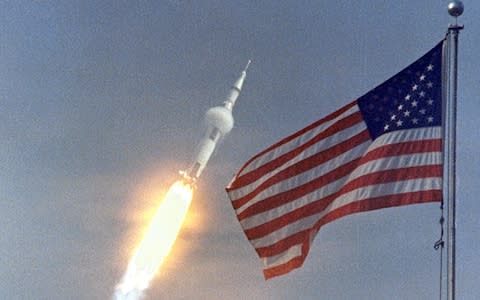
During the Houston press conference, Aldrin revealed that his late mother’s maiden name was Marion Moon. However, [he had] a sad secret.
His mother’s death the previous year had been the result of an overdose of sleeping pills, and he blamed himself for her suicide. She had struggled with depression in the past, and as attention surrounding her famous son increased, so did her anxiety, which proved overwhelming.
Despite their contrasting temperaments – Armstrong deceptively affectless and placid, Aldrin intense and focused – both were as competitive as the other alpha-male astronauts.
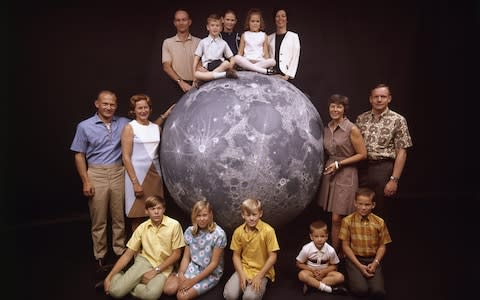
From the gallery of journalists came the inevitable question: ‘Which one of you gentlemen will be the first man to step on the lunar surface?’
Aldrin had begun training for the lunar extravehicular activity and had reason to assume that, as the lunar-module pilot, he would be the first to set foot on the moon, with Armstrong following him 40 minutes later.
However, when Armstrong answered the question, he revealed, uncomfortably, ‘The current plan calls for one astronaut to be on the surface for approximately three-quarters of an hour prior to the second man’s emergence. Now, which person is which has not been decided up to this point.’
Aldrin also left open the question of who would be first man. Outwardly, neither man showed much emotion about the matter. But the tension in the room did not go unnoticed.
A solution arose out of practical necessity. The designers of the lunar module had placed the hinge of the square exit door on its right side. When the door opened inward, the lunar-module pilot’s movement within the spacecraft’s cramped interior was confined; only the commander, on the left side of the cabin, had sufficient room to exit. Therefore, the commander would have to exit first and reenter last.
Aldrin was disappointed but professionally stoic whenever the issue was discussed.
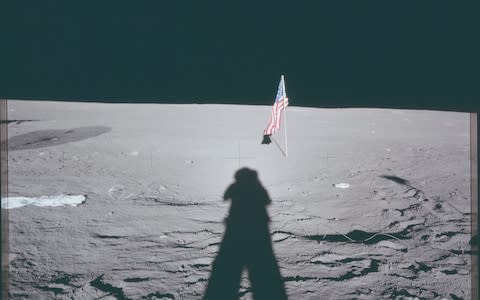
Although he received slightly less attention than his crewmates, Michael Collins [was] more socially at ease than they were. [He] possessed an observant eye and an understated wit. Collins described the Apollo 11 crew as ‘amiable strangers’, in contrast to other crews like Apollo 8, who bonded far more easily.
For Collins, the unique personal challenges were of an entirely different sort. By remaining in the command module [known as Columbia] in orbit above the moon while his crewmates were on the surface, he would experience a form of solitude unknown to any [other] human being.
During 47 minutes of each lunar orbit, Collins would be cut off from all communication and any sign of life.
On one side of the moon would be the Earth, with its three billion inhabitants as well as Armstrong and Aldrin. On the other side would be Collins, entirely alone.
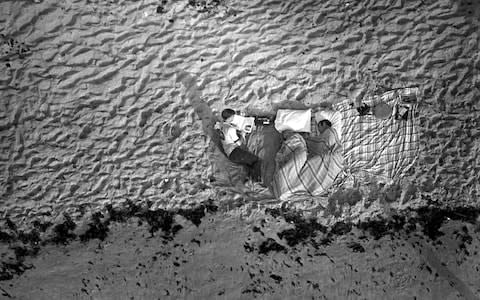
Apollo 11’s chosen landing site was a relatively level and smooth area in the Sea of Tranquillity, near the lunar equator. Should the moonwalk proceed as planned, the Apollo 11 crew would deploy a small array of scientific experiments, including a seismometer, a device to measure the solar wind, and an optical reflector.
It was hoped the latter would aid in determining the precise distance between the Earth and moon within an accuracy of about 3cm by using a laser beam sent from an Earth observatory station.
In early spring, Nasa convened a Committee on Symbolic Articles Related to the First Lunar Landing [which] resolved that nothing during the lunar landing should suggest the United States was laying claim to the moon’s sovereignty.
The State Department endorsed the idea of displaying the flag of the United Nations, a proposal that was immediately rejected by the Nixon White House.
As a compromise, the committee recommended that the American flag be planted in the lunar soil and that the achievement’s larger human context would be conveyed by the unveiling of a commemorative plaque with a text that would be read aloud during the first moonwalk.
The committee would not make any recommendations about one aspect of the mission that was increasingly invested with suspense: what Armstrong should say when taking his first step on another world.
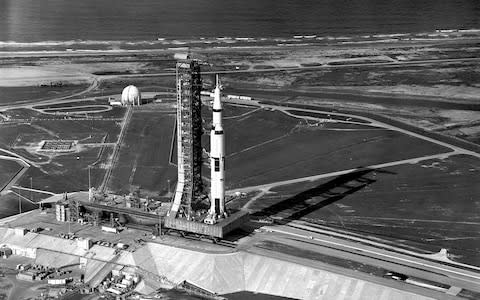
Armstrong was admired for his emotional stability, lack of ego, and ability to make split-second decisions when under pressure. However, among his peers, he was one of the least compelling public speakers. He would now be placed in a situation that had already been imagined by scores of writers, filmmakers and illustrators.
Esquire magazine commissioned a cover story that asked, ‘What words should the first man on the moon utter that will ring through the ages?’
When questioned about it in early July, Armstrong grinned and merely said he hadn’t given [the words] any consideration. In fact, one story indicates that, contrary to what he attested, he did do some advance preparation.
Armstrong’s brother, Dean, recalls that during a lull in a board game they were playing a few weeks before the launch, Neil handed his brother a piece of paper on which he had written a few words. He didn’t explain the context, but none was necessary. Dean Armstrong sensed his brother wanted some feedback. He responded with one word: ‘Fabulous.’
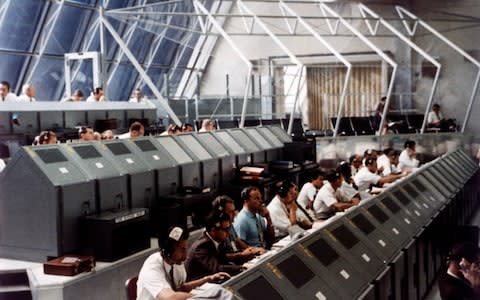
On the morning of Wednesday 16 July 1969, a few journalists assembled near the exit door of the Kennedy Space Center’s Operations Building before sunrise to catch a glimpse of Armstrong, Aldrin, and Collins as they boarded the white transport van that would drive them to the launchpad.
When the trio exited the building, carrying their suitcase-size portable air-conditioning and ventilation units, they waved to the small crowd. One eyewitness compared it to ‘watching Columbus sail out of port’.
An hour before launch, recognisable faces [began] arriving at the space centre. Vice President Spiro Agnew arrived with a contingent from the White House.
Since on orders from the Apollo flight surgeon, President Nixon had been prevented from dining with the astronauts the evening before the launch, he remained at the White House, where he prepared to watch the TV coverage with [Apollo 8’s] Frank Borman, and made plans to greet the crew on their return.
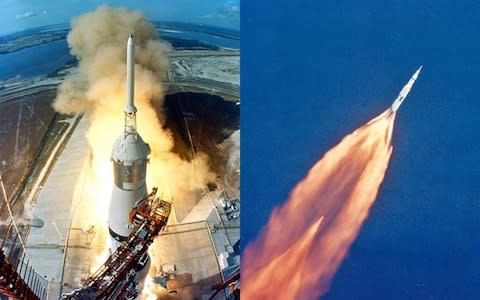
The television cameras followed the arrival of former president Lyndon Johnson and Lady Bird Johnson. The immediate suspense was heightening as the steady voice of Cape Canaveral’s veteran public-affairs announcer Jack King chronicled each moment of the countdown.
‘Twelve, eleven, ten, nine, ignition sequence start. Six, five, four, three, two, one, zero.’ Though his voice remained calm, the emotion of the moment affected King’s delivery, and he could be heard slightly stumbling his words as he said, ‘All engine run-ning.’
Quickly recovering his composure, he continued, ‘Lift-off! We have a lift-off, 32 minutes past the hour. Lift-off on Apollo 11.’
A wave of bodies rose to their feet, as everyone strained to get a better view and position their snapshot and 8mm movie cameras. Lady Bird Johnson beamed under a plastic cowboy hat. To her left, her husband watched the slow progress of the Saturn V.
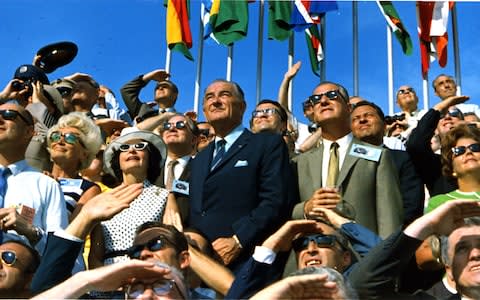
A few seconds after the billowing clouds at the base of the pad and the brilliant flame of the Saturn’s engines became visible, the observers heard a rolling and overpowering roar. With it came a buffeting concussive shock wave of pressure that could be felt through the ground and in the air pushing against their chests and eardrums.
The violent controlled combustion needed to lift 6.5 million pounds away from the force of the Earth’s gravity was an unequalled engineering achievement – and remains unequalled half a century later.
By late morning of Apollo 11’s fourth day, the crew had been in lunar orbit for nearly 24 hours. Armstrong and Aldrin had checked out all systems on the lunar module Eagle and were preparing to separate it from the Columbia module. It was 20 July.
Not long after Armstrong and Aldrin in the Eagle and Collins in Columbia reported that they had successfully undocked, the two spacecraft disappeared into radio silence as their orbits took them around the moon’s far side.
In Houston, those in Mission Control knew that one of three possible scenarios could play out within the next 90 minutes. The lunar module would either crash, abort the landing attempt, or successfully touch down on the lunar surface. [Nasa’s second chief flight director] Gene Kranz addressed the White House team over a private audio channel.
‘The hopes and the dreams of the entire world are with us. This is our time and our place, and we will remember this day and what we will do here always.’
Despite months of planning, the landing sequence contained hundreds of unknowns that could compromise the mission. Amid the curt audio communications peppered with technical acronyms, Armstrong and Aldrin offered few signs that revealed what they were feeling. Their voices remained alert and focused.
Suddenly, in the midst of the data-filled transmissions, both Armstrong and Aldrin called attention to a computer-program alarm unknown to them.
There was a sudden atypical urgency in Armstrong’s voice as he mentioned it and then followed with a request to Mission Control for an explanation.
It was a moment of added suspense that no one had expected. Had the alarm occurred during a practise simulation on the ground, a landing abort would likely have resulted. But the first powered descent to the lunar surface 239,000 miles from home was a rather different situation. Armstrong was determined to land successfully.
His instincts proved right. The alarm had been caused by an unintended information-overflow problem in the lunar module’s guidance system.
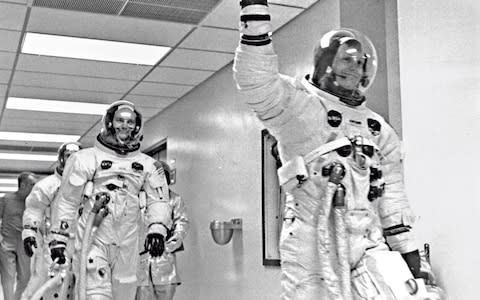
Armstrong’s attention soon turned to a bigger concern: the available fuel for the descent engine was running low as Eagle approached the moon’s surface.
He had a good idea of his height as he came in for the landing, but he needed to find a safe location. There were more large craters than he’d expected. His view of the surface was also becoming obscured as a mist of lunar-dust particles was agitated by the descent engine’s exhaust plume.
Armstrong hovered above the moon’s surface while gently manoeuvring the lunar module to find the best landing spot. More than a half minute passed beyond the projected touchdown time.
The descent engine’s fuel was running dangerously low, with only a few seconds of propellant remaining. In Houston there was still no word whether they had landed.
‘Contact light,’ Aldrin announced. A moment later Armstrong responded, ‘Shutdown.’
Armstrong later said he neither saw the contact light illuminate nor heard Aldrin announce it. The landing was so smooth, Armstrong couldn’t even tell the precise moment when they were on the surface. This was the climax of the mission, in Armstrong’s mind. The first step and moonwalk to come a few hours later were secondary.
Then from the moon came the official word as Armstrong announced, ‘Houston, Tranquillity Base here. The Eagle has landed.’
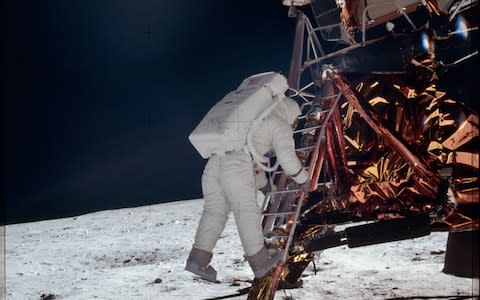
In New York’s Central Park, a crowd had gathered to watch the moonwalk broadcast on a large screen. Unfortunately it was beginning to rain, and preparations and depressurising the lunar module’s cabin took far longer than expected.
Movement inside the small cabin while wearing the stiffened pressure suits and large backpack life-support units was proving cumbersome. Rather than 9pm, it was a little after 10.30pm when the door of the lunar module was pulled inward to open.
[The] spectral, shadowy images [broadcast on televisions around the world came] from a small Westinghouse television camera, which Armstrong had deployed by pulling a release mechanism as he inched feet-first out of the lunar module.
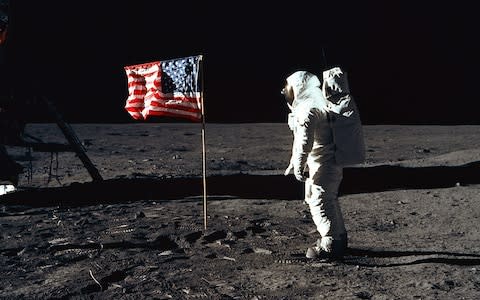
The television camera had been added to the lander very late in its development, and only after [Nasa’s assistant administrator of public affairs] Julian Scheer had learnt that the only broadcast camera scheduled to fly to the moon was the one designed exclusively for the command module.
The picture was ghostly, but Armstrong could be seen descending the ladder of the lunar module. From a position at the bottom of the lander’s footpad, Armstrong provided an initial report.
‘The surface appears to be very, very fine grained… It’s almost like a powder.’ And then, after an extended pause, Armstrong delivered the words for which he will be forever known: ‘That’s one small step for man, one giant leap for mankind.’
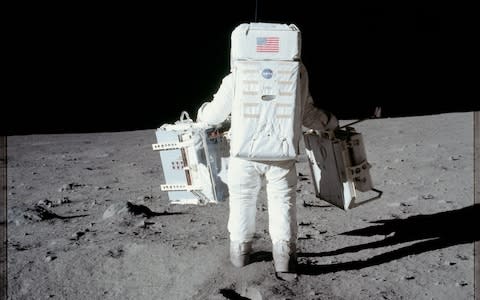
Armstrong’s training for that first step included one bizarre precaution for a wildly unlikely scenario. Some lunar scientists theorised that the moon’s surface might be combustible and that when Armstrong’s boot came into contact with the lunar soil, it could set off a reaction.
Everyone thought the chances of this occurring highly remote, but to be safe Armstrong was advised to touch the heel of his boot gently upon the lunar surface when extending his initial step. After taking a few more steps and bending his knees in the suit, Armstrong reported that he was experiencing no trouble walking or moving around.
His initial tasks before Aldrin joined him were to obtain a soil sample and take some photographs. After the sample was placed in a pouch attached to his leg, Armstrong took a panorama of the barren, flat landscape.
He reported that he found it starkly beautiful, not unlike the high desert of California. ‘It’s different, but it’s very pretty out here.’ Aldrin’s reaction when he joined Armstrong on the lunar surface was ‘Magnificent desolation’.
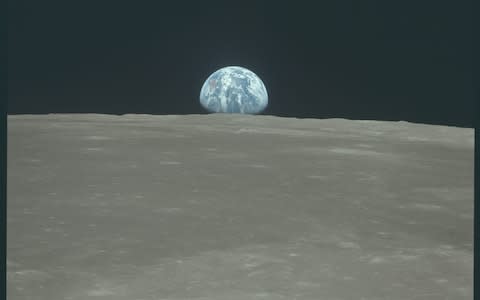
The harsh sunlight was coming from an angle 14 degrees above the horizon, this being a lunar morning, which would last longer than an entire Earth day. The relatively low angle of the sun also meant the lunar surface hadn’t yet reached the maximum temperature of 127C.
Armstrong and Aldrin’s first ceremonial task was to remove a protective metal cover from the memorial plaque.
Scheer had drafted the initial text, but [a] White House speechwriter had insisted on adding ‘A.D.’ (Anno Domini) after ‘July 1969’ so as to subtly acknowledge God. The final plaque read:
Here men from the planet Earth first set foot upon the moon July 1969, a.d. we came in peace for all mankind.
When, shortly after landing on the lunar surface, Aldrin had requested that ‘every person listening in… pause for a moment and contemplate the events of the past few hours and to give thanks in his or her own way’, few were aware he was in the process of taking communion with a small bit of bread, a plastic vial of wine and a silver chalice.
A second silent religious observance during the moonwalk may have occurred as well. Film-maker Theo Kamecke spoke with Neil Armstrong’s grandmother shortly after the moon landing.
‘Neil made me a promise,’ she told him. ‘He promised the first thing he would do when he stepped on the moon was to say a prayer.’
Kamecke concluded that this explained Armstrong’s unusually long pause when he stepped off the lunar module; he was saying a silent prayer ‘just between him and the universe’.
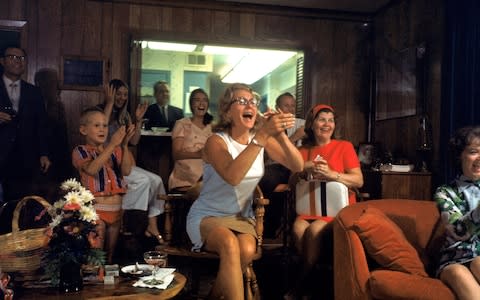
It was estimated that when Armstrong and Aldrin unveiled the plaque, one-fifth of the world’s population – 600 million people – was watching.
After mounting the small Westinghouse camera on a tripod to offer a long shot of their working area in front of the lunar module, Aldrin decided to give viewers a spontaneous demonstration.
First he walked at a regular pace, then he tried a kangaroo hop; he followed that with a manoeuvre in which he moved rapidly and then attempted to change direction by countering his momentum, putting his foot out to the side and making a cutting motion, which he likened to a football player dodging down a field.
Never forgetting the small television camera watching him, Aldrin made an effort to remain within the lens’s field of view. It turned out to be one of the highlights of the moonwalk.
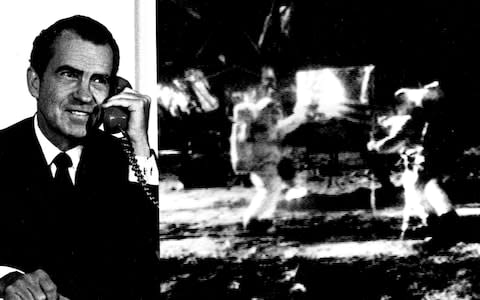
Before Armstrong and Aldrin deployed a small array of scientific instruments, there were two other ceremonial duties to perform. The first was the erection of the American flag, which had been outfitted with a simple metallic support to fully display it in the windless lunar environment.
The second was a live telephone call from President Richard Nixon in the White House, [which he] described as ‘the most historic telephone call ever to be made from the White House’.
‘As you talk to us from the Sea of Tranquillity,’ Nixon said, ‘it inspires us to redouble our efforts to bring peace and tranquillity to Earth. For one priceless moment, in the whole history of man, all the people on this Earth are truly one – one in their pride in what you have done, and one in our prayers that you will return safely to Earth.’
Now all attention was focused on the lunar module’s powered ascent from the surface, a procedure that had never been attempted, even by an automated spacecraft.
There existed no contingency backup should the lunar module’s ascent engine fail to operate properly. If it didn’t work, Collins would be forced to return alone.
At the New York Daily News, a typesetter had already prepared a special disaster edition of the paper if the astronauts were stranded on the moon. It was a stark front page with a one-word headline: Marooned!
Fortunately, Eagle’s launch countdown proceeded flawlessly. The ascent engine worked perfectly, and the subsequent rendezvous and docking with the command module in lunar orbit [were] almost routine.
All that remained was leaving lunar orbit and re-entry. Eight months earlier, the idea of executing both of these procedures had been fraught with suspense. Now, compared to what had just been accomplished, they seemed business as usual.
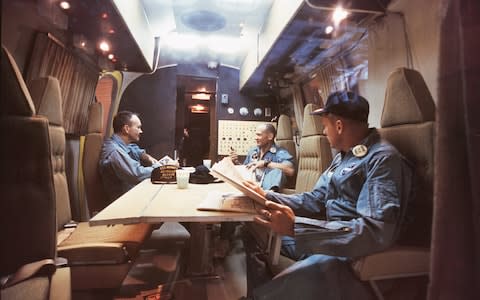
Minutes after Columbia’s successful splashdown, the trio was required to don biological isolation garments, and the men were then helicoptered [to] a specially prepared sealed living area constructed from a converted Airstream trailer.
This would serve as a temporary quarantine facility until their return to Houston where they would spend the remainder of a planned 21-day period of isolation.
All these precautions stemmed from the remote possibility that the astronauts could return with an unknown contagion.
When Nixon finally came face-to-face with the Apollo 11 crew, they looked at one another through a small plate-glass window and relied on microphones and speakers.
Standing outside the trailer, Nixon awkwardly engaged in small talk about baseball’s All-Star Game before pronouncing the recent events, ‘the greatest week in the history of the world since the creation’.
Nixon was as intoxicated by the moon landing as much of the world… He invited the crew to be honoured with the largest presidential state dinner ever planned.
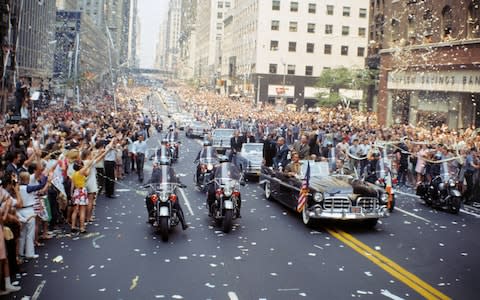
The ‘Dinner of the Century’, as the Los Angeles event a month later was nicknamed, was conceived as both a national patriotic observance and a television spectacular.
Massive ticker-tape parades in New York and Chicago had greeted the astronauts [before] they flew to the West Coast for the event.
A long calendar of tributes, parades, formal dinners and award ceremonies continued as the three men undertook an exhausting 37-day round-the-world ‘Giant Leap Goodwill Tour’.
Apollo demonstrated to the world that not only was it possible to dream the impossible dream, but it was achievable. While the world of the late 1960s was rife with turmoil and division, a better future seemed certain.
Abridged extract from Chasing the Moon: The Story of the Space Race – from Arthur C Clarke to the Moon Landings, by Robert Stone and Alan Andres (William Collins, £20). To order your copy for the discounted price of £16.99, visit books.telegraph.co.uk

